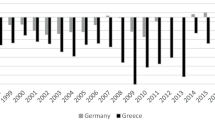Abstract
Much of the volatility in emerging markets in the 1990s stems from the fact that the major form of foreign investment is the bond rather than the bank loans which predominated until the debt crisis of the 1980s. Bondholders are too dispersed to negotiate with during a liquidity shortfall. Thus, a shortage of reserves becomes a full-blown crisis. This was not the case in the 1980s when banks, as the major creditors, often lent to countries in arrears. The risk to a loan is therefore rescheduling, while the risk to a bond is default. Empirically pricing loans and bonds as assets reveals that bonds incorporate the greater risk of default into their spreads. Debentures are thus riskier credit than loans. As developing countries now obtain most finance through these risky instruments, the volatility of the 1990s is better understood.
Similar content being viewed by others
References
Chang, Roberto; Velasco, Andres. "Financial Crises in Emerging Markets: A Canonical Model," Federal Reserve Bank of Atlanta, working paper, 98–10, March 1998.
Chemmanur, Thomas; Fulghieri, Paolo. "Reputation, Renegotiation and the Choice Between Bank Loans and Publicly Traded Debt,"Review of Financial Studies, 7, 3, Fall 1994, pp. 475–506.
Cline, William.International Debt Reexamined, Washington, DC: Institute for International Economics, 1995.
Cooper, Richard; Sachs, Jeffrey. "Borrowing Abroad: The Debtor's Perspective," in Gordon Smith; John Cuddington, eds.,International Debt and the Developing Countries, Washington, DC: World Bank, 1985, pp. 21–60.
Diamond, Douglas. "Monitoring and Reputation: The Choice Between Bank Loans and Directly Placed Bonds,Journal of Political Economy, 99, 3, August 1991, pp. 689–719.
Eaton, Jonathan; Gersovitz, Mark. "Debt with Potential Repudiation: Theoretical and Empirical Analysis,"Review of Economic Studies, 48, 152, April 1981, pp. 289–309.
Edwards, Sebastian. "LDC Borrowing and Foreign Default Risk: An Empirical Analysis,"American Economic Review, 74, 4, September 1984, pp. 726–34.
__. "The Pricing of Bonds and Loans in International Markets: An Empirical Analysis of Developing Countries' Foreign Borrowing,"European Economic Review, 30, 3, June 1986, pp. 565–89.
Fama, Eugene. "What's Different About Banks?,"Journal of Monetary Economics, 15, 1, January 1985, pp. 29–39.
Feder, Gershon; Just, Richard E. "An Analysis of Credit Terms in the Eurodollar Market,"European Economic Review, 9, 2, May 1977, pp. 221–43.
Folkerts-Landau, David. "The Changing Role of International Bank Lending in Development Finance,"IMF Staff Papers, 32, 2, June 1985, pp. 316–33.
Frenkel, Jacob. "International Liquidity and Monetary Control," in George von Furstenburg, ed.,International Money and Credit: The Policy Roles, Washington DC: International Monetary Fund, 1983, pp. 65–109.
Gersovitz, Mark. "Banks' International Lending Decisions: What We Know and Implications for Future Research," in Gordon Smith; John Cuddington, eds.,International Debt and the Developing Countries, Washington DC: World Bank, 1985, pp. 61–78.
International Monetary Fund.Private Market Financing for Developing Countries, Washington, DC: IMF, November 1995, pp. 70–84.
__.International Financial Statistics, Washington DC: IMF, various.
Ozler, Sule. "The Evolution of Credit Terms: An Empirical Study of Commercial Bank Lending to Developing Countries,"Journal of Development Economics, 38, 1, January 1992, pp. 79–97.
__. "Have Commercial Banks Ignored History?,"American Economic Review, 83, 3, June 1993, pp. 608–20.
Sachs, Jeffrey; Tornell, Aaron; Velasco, Andres. "The Collapse of the Mexican Peso: What Have We Learned,"NBER Working Papers, 4142, June 1996.
White, Halbert. "A Heteroskedastic-Consistent Covariance Matrix Estimator and a Direct Test for Heteroskedasticity,"Econometrica, 48, 1980, pp. 817–38.
World Bank.World Debt Tables, Washington, DC: World Bank, various.
Zeger, Scott L.; Liang, Kung-Yee. "Longitudinal Data Analysis for Discrete and Continuous Outcomes,"Biometrics, 42, 1, March 1986, pp. 121–30.
Author information
Authors and Affiliations
Rights and permissions
About this article
Cite this article
Miles, W. The pricing of risk in emerging credit markets: Bonds versus loans. International Advances in Economic Research 6, 221–231 (2000). https://doi.org/10.1007/BF02296103
Issue Date:
DOI: https://doi.org/10.1007/BF02296103




